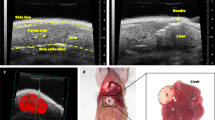Summary
The aim of this study was to determine whether subrenal capsule (SRC) implantation is a suitable model for the study of the metastatic potential of our human renal cell carcinoma (HRCC) lines and to establish new sublines with enhanced metastatic ability. NMRI athymic nude mice 7–11 weeks old received SRC implantation of our HRCC lines RC43 and RC21. These lines were not metastatic when implanted s.c. Mice were killed after 4 or 8 weeks, or when moribund. With the RC43 cell line the success rate for implantation was 69%, with 89% of these showing metastases. The average volume of the implanted tumour fragments was 0.5 mm3 (range 0.28–0.7), the average volume at the primary site at the time of death was 9087 (9–32000) mm3. Metastases were found in lymph nodes, liver, spleen, peritoneum, psoas muscle, pancreas, diaphragm and skin. The average volume of the metastases was 4139 (0.5–9000) mm3. Growing cell lines were established in vivo and in vitro from one splenic, one peritoneal, one diaphragmatic, and one hepatic metastasis. These sublines have faster in vivo and slower in vitro growth rates than the parental lines. With the RC21 cell line the success rate for implantation was 56% and the metastatic rate 78%. The average volume of the implanted tumour was 0.8 mm3 (0.28–1.2), the average volume at the primary site at the time of death was 2685 mm3 (1.4–6534) and the average volume of metastases was 7.1 mm3 (0.5–37.5). Metastases were found in lymph nodes, lung and skin. No establishment was attempted for RC21 because of the small dimensions of these metastases. SRC implantation is thus considered a useful tool for the study of the metastatic ability of our cell lines RC43 and RC21. The establishment of new sublines with a faster growth rate and an enhanced metastatic ability will be useful for further studies on the metastatic process.
Similar content being viewed by others
References
Paget S (1989) The distribution of secondary growth in cancer of breast. Lancet 1:571
Johnson DE, Swanson DA, Von Eschenbach A (1988) Tumors of the genitourinary tract. In: Tanagho EA, McAnich JW (eds) Smith's General Urology, 12th ed. Prentice Hall, Englewood Cliffs, NJ, p 310
Kurth KH, Romijn JC, Van Dongen JW, Lieber MM, Schroeder FH (1986) Experimental chemotherapy of renal adenocarcinoma. In: deKernion JB, Pavone-Macaluso M (eds) Tumors of the kidney. Williams & Wilkins, Baltimore, Md, p 228
Hanna H (1980) Expression of metastatic potential of tumor cells in young mice is correlated with low levels of NK cell-mediated cytotoxity. Int J Cancer 26:675
Bogden AE, Haskell PM, lePage DJ, Kelton DE, Cobb WR, Esber HJ (1979) Growth of human tumour xenografts implanted under the renal capsule of normal immunocompetent mice. Exp Cell Biol 47:281
Van Steenbrugge GJ, Groen M, Romijn JC, Schroeder FH (1984) Biological effects of hormonal treatment regimens on a transplantable human prostatic tumor line. J Urol 131:812
Romijn JC, Verkoelen CF, Schroeder FH (1988) Application of the MTT assay to human prostate cancer cell lines in vitro: establishment of test conditions and assessment of hormonestimulated growth and drug-induced cytostatic and cytotoxic effects. Prostate 12:99
Fidler IJ (1990) Critical factors in the biology of human cancer metastasis: Twenty-eight G.H.A. Clowes Memorial Award lecture. Cancer Res 50:6130
Bogden AE, Cobb WR, lePage DJ, Haskell PM, Gulkin TA, Ward A, Kelton DE, Esber HJ (1981) Chemotherapy responsiveness of human tumors on first transplant generation xenografts in the normal immunocompetent mouse: 6 days subrenal capsule assay. Cancer 48:10
Bogden AE, Von Hoff DD (1984) Comparison of the human tumour cloning and subrenal capsule assay. Cancer Res 44:1087
Fidler IJ, Naito S, Pethak S (1990) Orthotopic implantation is essential for the selection, growth and metastasis of human renal cell carcinoma in nude mice. Cancer Metastasis Rev 9:149
Tabuchi Y, Nakamura T, Saitoh Y (1991) Liver metastases induced by implantation of VX2 cancer in to the gastrointestine. J Surg Res 50:216
Ibrahiem EHI, Nigam VN, Brailosky CA, Nadermas P, Elhilali M (1983) Orthotopic implantation of primary (N-[4-(5-nitro-2-furyl)-2-thiazolyl])formamide-induced bladder cancer in bladder submucosa: an animal model for bladder cancer study. Cancer Res 43:617
Morikawa K, Walker SM, Jessup JM, Fidler IJ (1988) In vivo selection of highly metastatic cells from surgical specimens of different human colon carcinoma implanted in to different organs of nude mice. Cancer Res 48:1943
Bresalier RS, Raper SE, Hujanen ES, Kim YS (1987) A new model for human colon cancer metastasis. Int J Cancer 39:625
Kerbel RS, Man MS, Dexter D (1984) A model of human cancer metastasis: extensive spontaneous nd artificial metastases of a human pigmented melanoma nd derived variant sublines in nude mice. J Natl Cancer Inst 72:92
Shafie LLA (1980) formation of metastases by human breast carcinoma cells (MCF-7) in nude mice. Cancer Lett 11:81
Author information
Authors and Affiliations
Rights and permissions
About this article
Cite this article
Grossi, F.S., Zhao, X., Romijn, J.C. et al. Metastatic potential of human renal cell carcinoma: experimental model using subrenal capsule implantation in athymic nude mice. Urol. Res. 20, 303–306 (1992). https://doi.org/10.1007/BF00300264
Accepted:
Issue Date:
DOI: https://doi.org/10.1007/BF00300264




